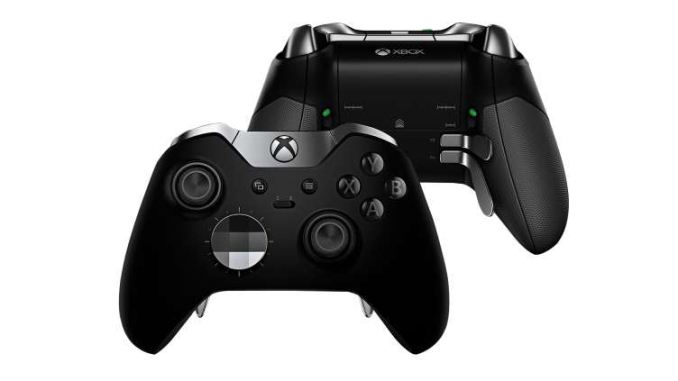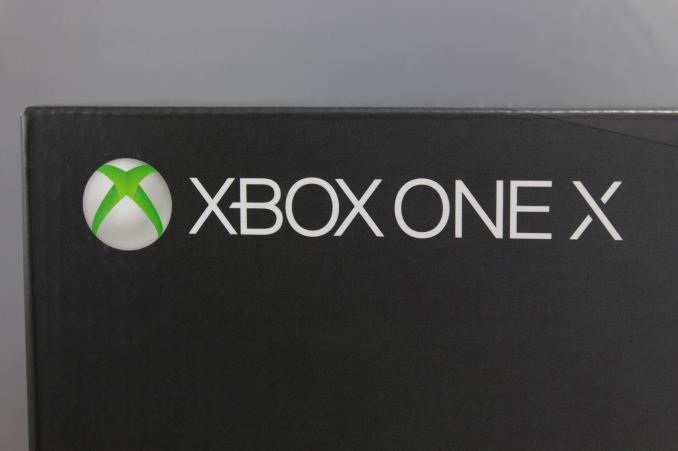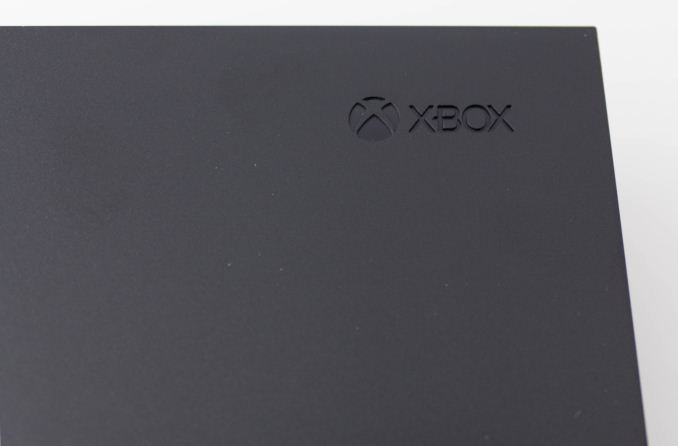The Xbox One X Review: Putting A Spotlight On Gaming
by Brett Howse on November 3, 2017 3:01 AM EST- Posted in
- Consoles
- Microsoft
- Xbox One
- Xbox
- Xbox One X
Final Words
The Xbox One X is the third generation of the Xbox One, with the Xbox One S launching just over a year ago, but this is not just a smaller device. The X is a huge jump in performance over the original console, and if anyone doubted Microsoft’s commitment to the gaming console, this seems to answer it. When the original Xbox One launched against the PlayStation 4, it touted its media capabilities, but came out of the gate with less performance. PlayStation has taken advantage of that misstep, but Xbox is now answering back with a console that leaves no doubt about which one has the most gaming power inside.
Microsoft had some “table stakes” in their ambitions with the Xbox One X, which were no compromise decisions. Their strategy has become “no gamer left behind” and with the Xbox One X, they’ve succeeded. All of the games, apps, and accessories that work with the Xbox One and S will just work, and sometimes better, on the Xbox One X. Compared to the old console strategy of a new device every couple of years, this is a very welcome change. Add in all of the work Microsoft has done with backwards compatibility for the Xbox 360 games, and now even original Xbox games, and it seems like no gamer will be left behind.
With 6 TFLOPS of peak shader throughput, the Xbox One X truly can, and does, game at 4K. But, that doesn’t mean every Xbox One X Enhanced title is going to target 4K. There’s a lot you can do with the extra shader performance to increase visuals, and Microsoft has left it up to the developers to decide how they want to use the extra performance. From the Xbox side, their goal was to provide the same tools, which are already well known to developers, but with more performance available.
Impressively, Microsoft already has over 130 games announced which will offer an Xbox One X Enhanced mode. This is one of the best parts about getting rid of console generations, since there’s already a wide array of content available. Compare this to a new generational launch, when there’s always a slow ramp up of games and content, and it makes buying into the ecosystem a lot easier.
It’s also great to see that the Enhanced titles will offer gamers choice in how they want to utilize the extra performance, for at least a few titles. Choosing between higher framerates, or better visuals, is a great choice to give gamers.
Despite the added performance, the Xbox One X is actually slightly smaller overall than even the Xbox One S, and if you own the original console, it’s hard to believe how much smaller the new one is. This also includes the built-in power supply, which was external on the original console. The overall design of the Xbox One X is quite well done, and will easily blend into any A/V stand. The choice of black as the base color helps here as well, although there will almost certainly be special color versions of the console later on.
The excellent design also continues with a lot of work done on sound and cooling. As we saw in our power draw tests, the Xbox One X can draw up to about 170 Watts of power at full load, but the cooling system is more than up to the task of keeping everything working, without sounding like a leaf blower. The console is barely audible at idle, and we only recorded 41 dB (A) with a SPL meter six inches in front of the console at full load. The vapor chamber cooling system keeps everything in check.
On the gaming front, the Xbox One X does what it was set out to do. On the media side, there’s a lot to like as well, including a built-in UHD Blu-Ray player, support for Dolby Atmos, bitstream passthrough, and HDR 10. It doesn’t quite check all the boxes, since there’s no support for Dolby Vision, but that’s arguably not a huge deal for most people.
Really the only area where the Xbox One X is let down in terms of media playback is Netflix, which forces HDR on for all content when connected to an HDR TV, which plays havoc with the colors of SDR content, which, at the moment, is most of it. It’s a flaw that Amazon Prime avoids, so this is on Netflix, but because of this flaw it’s hard to recommend the Xbox One X as a primary media device. There’s also the fact that it draws 50-60 Watts when streaming video, of course.
Microsoft has also built up an impressive set of accessories for Xbox, including the fantastic Xbox One Elite Controller, and the Xbox Design Labs, where you can custom build your own controller. These are nice touches to the ecosystem. Xbox Live has also improved dramatically since the original One launched, and now includes Games with Gold which provide up to four games every month as part of the subscription. If you want to go all in on gaming subscriptions, there’s also the Xbox Game Pass which gives access to over 100 games for a monthly charge, and Xbox also offers EA Access as well, which provides access to over 50 games for a monthly subscription.
 Xbox One Elite Controller (sold separately)
Xbox One Elite Controller (sold separately)
If you are a console gamer, there’s going to be little to not like about the Xbox One X, except maybe the price. It’s a steep jump, since the Xbox One S can usually be found for close to $250, and that generally includes a game, whereas the Xbox One X is $499 right now with no games included. But even if you don’t own a 4K TV, the Xbox One X is going to provide much better visuals than the S, even though both will output at 1080p, thanks to the downscaling of higher resolution graphics on the X.
Comparing to the PlayStation 4, and PlayStation 4 Pro, Microsoft can compete with both the Xbox One S, which offers a UHD Blu-Ray drive on top of 4K support for media, and HDR support for games, at a low entry level price, but the Xbox One X is priced about $100 higher than the PlayStation 4 Pro. This is the same price gap that existed when the Xbox One and Playstation 4 first launched. The difference is this time, the extra $100 gains you a lot of performance. Xbox isn't the market leader right now though, so this might be a gamble.
The Xbox One X sets a new bar for console performance. The team seems like they’ve gotten back to gaming as a focus, which is great to see. Gaming is always about more than just the hardware though, and any console needs a great set of exclusives to drive adoption. Microsoft has some of their own IP, such as Forza, Gears of War, and Halo, but they are still going to face some tough competition. They have the hardware now though, to drive console gaming to the next level.













128 Comments
View All Comments
abrowne1993 - Friday, November 3, 2017 - link
Wow, surprised to see a console review here. And before it even launches, at that.yhselp - Friday, November 3, 2017 - link
Great article. Thanks. Just one thing I didn't understand - why would XBO's DDR3 account for its performance deficit when its eSRAM buffer actually has higher bandwidth than PS4's GDDR5, albeit limited to 32 MB? I thought XBO's performance deficit comes from its weaker GPU. Can you explain, please?yhselp - Friday, November 3, 2017 - link
Ignore me, I apologize, just realized what you meant to say - that picking DDR3 necessitated an eSRAM buffer, which limited their ability to put more stuff on-chip, which resulted in a weaker GPU. Have never thought of it this way, thanks for making it clear.yhselp - Friday, November 3, 2017 - link
It's also quite ironic that by deciding against GDDR5, Microsoft essentially guaranteed that Sony would not run into production limitations with the PS4.rasmithuk - Friday, November 3, 2017 - link
I think the article is wrong here.GDDR5 was available in volume, but not in 4Gb packages (which were required to get a sensible board layout).
2Gb were available, but without going for riser cards they could only get 16 on the board, giving a limit of 4GB of RAM.
4Gb chips became available late 2012, too late for Microsoft to change the whole console design to use, but early enough for Sony (who were happy with 4GB of RAM on the PS4) to switch.
Rufnek - Monday, November 6, 2017 - link
@rasmithukYou may be entirely correct, but the reality is that Sony found a way to get GDDR5 memory in the console, with a built in power supply now less, in a much smaller space than the One Without an internal power supply. Reasoning is really that one company chose to spend real money on a compact design, and the other company was really looking to keep costs at a minimum.
novastar78 - Monday, November 6, 2017 - link
This is actually 100% correct based on the sources I've talked to.MS wanted 8GB because of the vitualized OS they wanted to give more headroom so they needed 8GB.
tipoo - Friday, November 3, 2017 - link
32MB of high bandwidth memory vs all 8GB being that bandwidth.Samus - Saturday, November 4, 2017 - link
The real problem is the SRAM just isn't much faster than GDDR5 in the first place. It only looks fast when you compare it to DDR3.Microsoft really screwed up going with DDR3. There was no excuse really. I agree with rasmithuk that the packaging they needed wasn't available for the board footprint, but that could have been worked out in the short turn (in the form of bigger initial losses on hardware sales as well) but the real head scratcher is consoles don't even use high speed GDDR5.
They use the 6-7Ghz variety. Which is not only substantially less expensive, but has never been remotely close to a "supply shortage." When you read about shortages, it's of stuff at the ultra high end. Look at 3D NAND, GDDR5X, HBM2. These all have low yields because they are new technology. GDDR5 at 8Ghz initially had low yields as well, and it was never considered for consoles, particularly because AMD has historically stayed away from 8GHz GDDR5.
StevoLincolnite - Friday, November 3, 2017 - link
No mention of how the ROPS don't align perfectly with the memory bus? Resulting in a Radeon 7970-memory like situation?